Organizational Behaviour Report: Leadership and Culture at Tesco
VerifiedAdded on 2023/01/12
|15
|4982
|29
Report
AI Summary
This report provides a comprehensive analysis of organizational behaviour, focusing on the case of Tesco Plc. It delves into the characteristics of different organizational structures, exploring their strengths, weaknesses, and impact on operational efficiency. The report examines how organizational culture influences effectiveness, highlighting key characteristics and their effects on employee behavior and performance. It also investigates the impact of learning and training on employee effectiveness, emphasizing the benefits of continuous development and the importance of employee satisfaction. Furthermore, the report discusses how teamwork can improve employee effectiveness, and explores different leadership behavior theories and their impact on organizations. The analysis extends to employee motivation, examining different motivational theories and their application within Tesco. The report also assesses the benefits and issues of employee involvement in decision-making, and evaluates how Tesco motivates its employees, offering insights into organizational strategies for enhancing employee engagement and productivity.
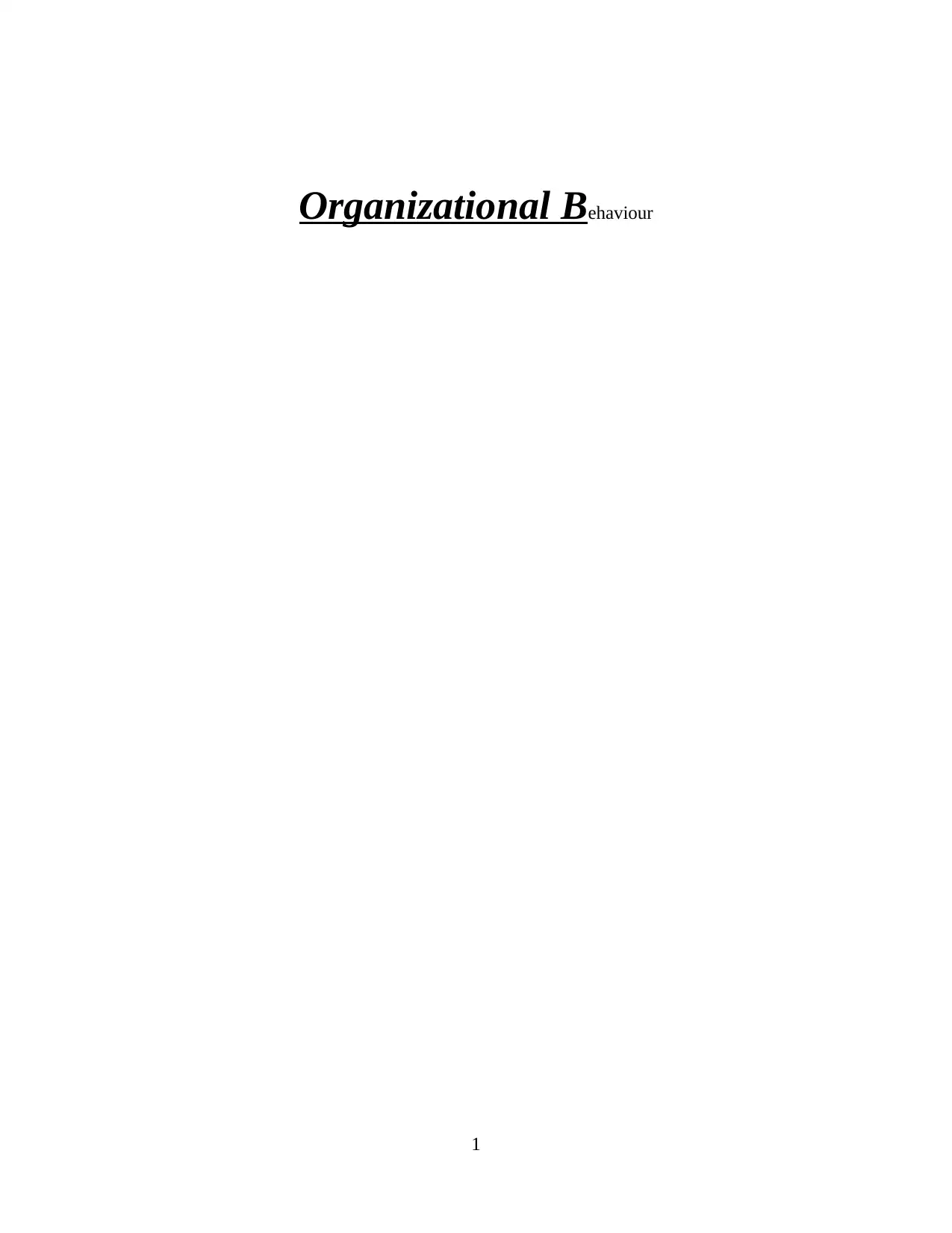
Organizational Behaviour
1
1
Paraphrase This Document
Need a fresh take? Get an instant paraphrase of this document with our AI Paraphraser
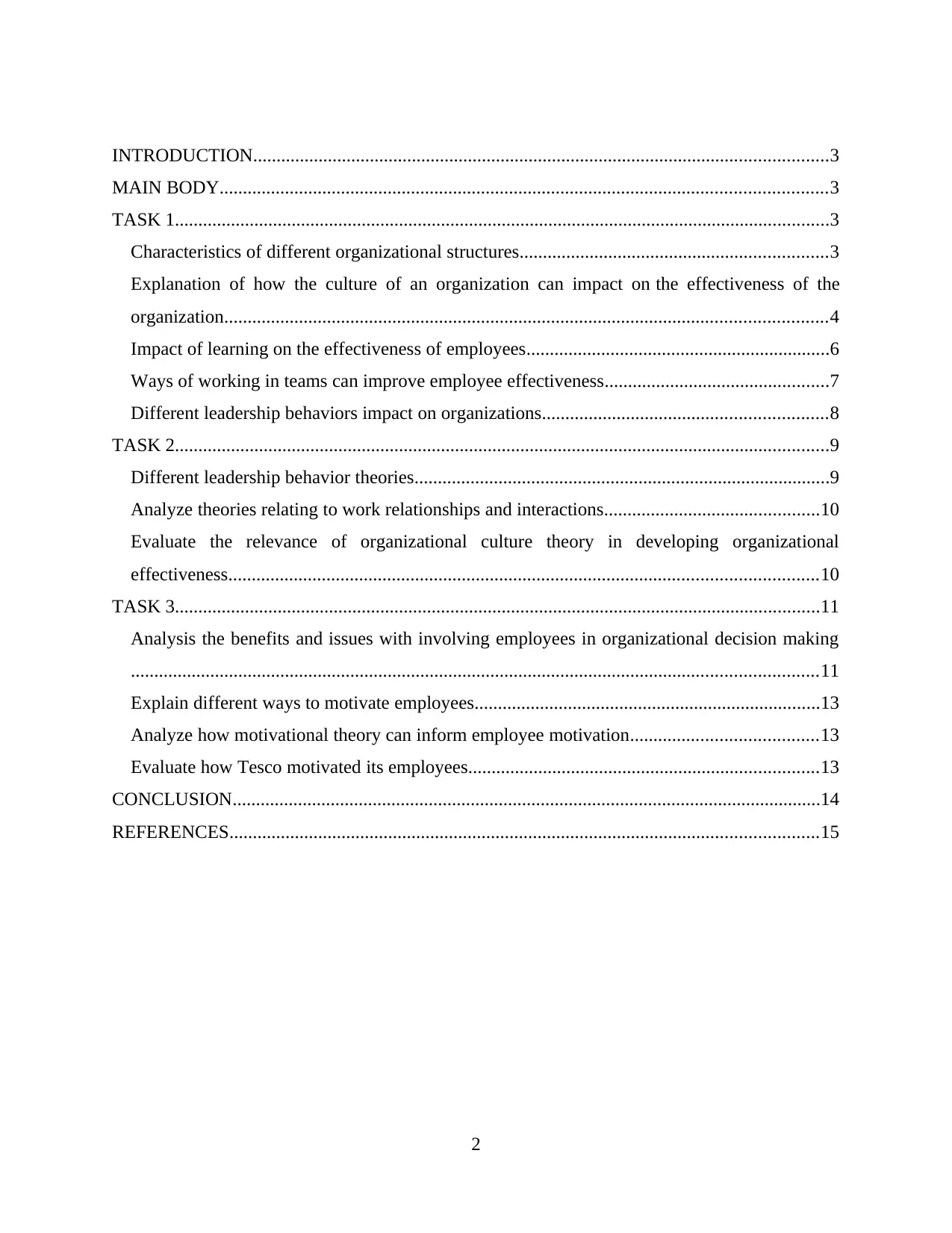
INTRODUCTION...........................................................................................................................3
MAIN BODY..................................................................................................................................3
TASK 1............................................................................................................................................3
Characteristics of different organizational structures..................................................................3
Explanation of how the culture of an organization can impact on the effectiveness of the
organization.................................................................................................................................4
Impact of learning on the effectiveness of employees.................................................................6
Ways of working in teams can improve employee effectiveness................................................7
Different leadership behaviors impact on organizations.............................................................8
TASK 2............................................................................................................................................9
Different leadership behavior theories.........................................................................................9
Analyze theories relating to work relationships and interactions..............................................10
Evaluate the relevance of organizational culture theory in developing organizational
effectiveness..............................................................................................................................10
TASK 3..........................................................................................................................................11
Analysis the benefits and issues with involving employees in organizational decision making
...................................................................................................................................................11
Explain different ways to motivate employees..........................................................................13
Analyze how motivational theory can inform employee motivation........................................13
Evaluate how Tesco motivated its employees...........................................................................13
CONCLUSION..............................................................................................................................14
REFERENCES..............................................................................................................................15
2
MAIN BODY..................................................................................................................................3
TASK 1............................................................................................................................................3
Characteristics of different organizational structures..................................................................3
Explanation of how the culture of an organization can impact on the effectiveness of the
organization.................................................................................................................................4
Impact of learning on the effectiveness of employees.................................................................6
Ways of working in teams can improve employee effectiveness................................................7
Different leadership behaviors impact on organizations.............................................................8
TASK 2............................................................................................................................................9
Different leadership behavior theories.........................................................................................9
Analyze theories relating to work relationships and interactions..............................................10
Evaluate the relevance of organizational culture theory in developing organizational
effectiveness..............................................................................................................................10
TASK 3..........................................................................................................................................11
Analysis the benefits and issues with involving employees in organizational decision making
...................................................................................................................................................11
Explain different ways to motivate employees..........................................................................13
Analyze how motivational theory can inform employee motivation........................................13
Evaluate how Tesco motivated its employees...........................................................................13
CONCLUSION..............................................................................................................................14
REFERENCES..............................................................................................................................15
2
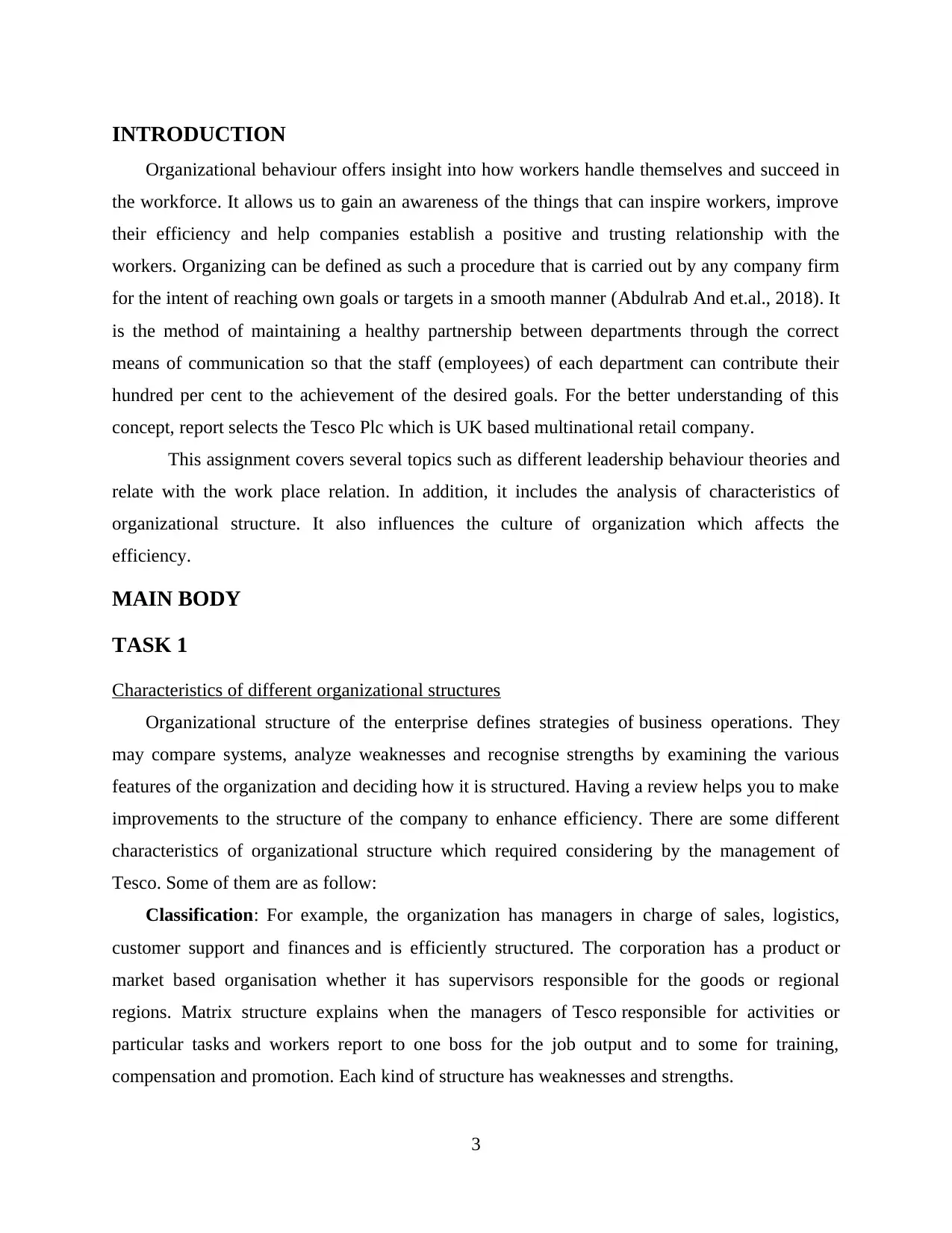
INTRODUCTION
Organizational behaviour offers insight into how workers handle themselves and succeed in
the workforce. It allows us to gain an awareness of the things that can inspire workers, improve
their efficiency and help companies establish a positive and trusting relationship with the
workers. Organizing can be defined as such a procedure that is carried out by any company firm
for the intent of reaching own goals or targets in a smooth manner (Abdulrab And et.al., 2018). It
is the method of maintaining a healthy partnership between departments through the correct
means of communication so that the staff (employees) of each department can contribute their
hundred per cent to the achievement of the desired goals. For the better understanding of this
concept, report selects the Tesco Plc which is UK based multinational retail company.
This assignment covers several topics such as different leadership behaviour theories and
relate with the work place relation. In addition, it includes the analysis of characteristics of
organizational structure. It also influences the culture of organization which affects the
efficiency.
MAIN BODY
TASK 1
Characteristics of different organizational structures
Organizational structure of the enterprise defines strategies of business operations. They
may compare systems, analyze weaknesses and recognise strengths by examining the various
features of the organization and deciding how it is structured. Having a review helps you to make
improvements to the structure of the company to enhance efficiency. There are some different
characteristics of organizational structure which required considering by the management of
Tesco. Some of them are as follow:
Classification: For example, the organization has managers in charge of sales, logistics,
customer support and finances and is efficiently structured. The corporation has a product or
market based organisation whether it has supervisors responsible for the goods or regional
regions. Matrix structure explains when the managers of Tesco responsible for activities or
particular tasks and workers report to one boss for the job output and to some for training,
compensation and promotion. Each kind of structure has weaknesses and strengths.
3
Organizational behaviour offers insight into how workers handle themselves and succeed in
the workforce. It allows us to gain an awareness of the things that can inspire workers, improve
their efficiency and help companies establish a positive and trusting relationship with the
workers. Organizing can be defined as such a procedure that is carried out by any company firm
for the intent of reaching own goals or targets in a smooth manner (Abdulrab And et.al., 2018). It
is the method of maintaining a healthy partnership between departments through the correct
means of communication so that the staff (employees) of each department can contribute their
hundred per cent to the achievement of the desired goals. For the better understanding of this
concept, report selects the Tesco Plc which is UK based multinational retail company.
This assignment covers several topics such as different leadership behaviour theories and
relate with the work place relation. In addition, it includes the analysis of characteristics of
organizational structure. It also influences the culture of organization which affects the
efficiency.
MAIN BODY
TASK 1
Characteristics of different organizational structures
Organizational structure of the enterprise defines strategies of business operations. They
may compare systems, analyze weaknesses and recognise strengths by examining the various
features of the organization and deciding how it is structured. Having a review helps you to make
improvements to the structure of the company to enhance efficiency. There are some different
characteristics of organizational structure which required considering by the management of
Tesco. Some of them are as follow:
Classification: For example, the organization has managers in charge of sales, logistics,
customer support and finances and is efficiently structured. The corporation has a product or
market based organisation whether it has supervisors responsible for the goods or regional
regions. Matrix structure explains when the managers of Tesco responsible for activities or
particular tasks and workers report to one boss for the job output and to some for training,
compensation and promotion. Each kind of structure has weaknesses and strengths.
3
⊘ This is a preview!⊘
Do you want full access?
Subscribe today to unlock all pages.

Trusted by 1+ million students worldwide
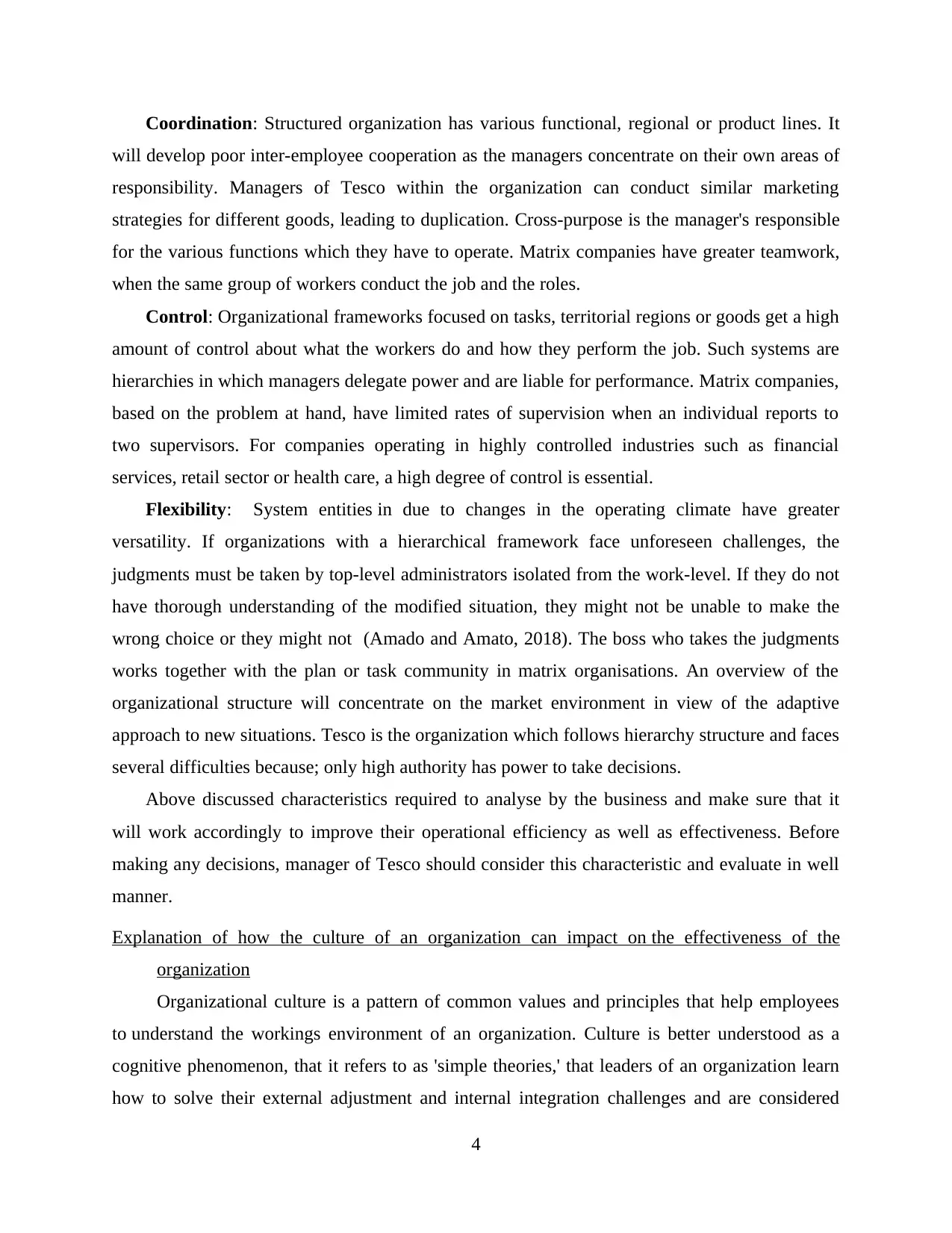
Coordination: Structured organization has various functional, regional or product lines. It
will develop poor inter-employee cooperation as the managers concentrate on their own areas of
responsibility. Managers of Tesco within the organization can conduct similar marketing
strategies for different goods, leading to duplication. Cross-purpose is the manager's responsible
for the various functions which they have to operate. Matrix companies have greater teamwork,
when the same group of workers conduct the job and the roles.
Control: Organizational frameworks focused on tasks, territorial regions or goods get a high
amount of control about what the workers do and how they perform the job. Such systems are
hierarchies in which managers delegate power and are liable for performance. Matrix companies,
based on the problem at hand, have limited rates of supervision when an individual reports to
two supervisors. For companies operating in highly controlled industries such as financial
services, retail sector or health care, a high degree of control is essential.
Flexibility: System entities in due to changes in the operating climate have greater
versatility. If organizations with a hierarchical framework face unforeseen challenges, the
judgments must be taken by top-level administrators isolated from the work-level. If they do not
have thorough understanding of the modified situation, they might not be unable to make the
wrong choice or they might not (Amado and Amato, 2018). The boss who takes the judgments
works together with the plan or task community in matrix organisations. An overview of the
organizational structure will concentrate on the market environment in view of the adaptive
approach to new situations. Tesco is the organization which follows hierarchy structure and faces
several difficulties because; only high authority has power to take decisions.
Above discussed characteristics required to analyse by the business and make sure that it
will work accordingly to improve their operational efficiency as well as effectiveness. Before
making any decisions, manager of Tesco should consider this characteristic and evaluate in well
manner.
Explanation of how the culture of an organization can impact on the effectiveness of the
organization
Organizational culture is a pattern of common values and principles that help employees
to understand the workings environment of an organization. Culture is better understood as a
cognitive phenomenon, that it refers to as 'simple theories,' that leaders of an organization learn
how to solve their external adjustment and internal integration challenges and are considered
4
will develop poor inter-employee cooperation as the managers concentrate on their own areas of
responsibility. Managers of Tesco within the organization can conduct similar marketing
strategies for different goods, leading to duplication. Cross-purpose is the manager's responsible
for the various functions which they have to operate. Matrix companies have greater teamwork,
when the same group of workers conduct the job and the roles.
Control: Organizational frameworks focused on tasks, territorial regions or goods get a high
amount of control about what the workers do and how they perform the job. Such systems are
hierarchies in which managers delegate power and are liable for performance. Matrix companies,
based on the problem at hand, have limited rates of supervision when an individual reports to
two supervisors. For companies operating in highly controlled industries such as financial
services, retail sector or health care, a high degree of control is essential.
Flexibility: System entities in due to changes in the operating climate have greater
versatility. If organizations with a hierarchical framework face unforeseen challenges, the
judgments must be taken by top-level administrators isolated from the work-level. If they do not
have thorough understanding of the modified situation, they might not be unable to make the
wrong choice or they might not (Amado and Amato, 2018). The boss who takes the judgments
works together with the plan or task community in matrix organisations. An overview of the
organizational structure will concentrate on the market environment in view of the adaptive
approach to new situations. Tesco is the organization which follows hierarchy structure and faces
several difficulties because; only high authority has power to take decisions.
Above discussed characteristics required to analyse by the business and make sure that it
will work accordingly to improve their operational efficiency as well as effectiveness. Before
making any decisions, manager of Tesco should consider this characteristic and evaluate in well
manner.
Explanation of how the culture of an organization can impact on the effectiveness of the
organization
Organizational culture is a pattern of common values and principles that help employees
to understand the workings environment of an organization. Culture is better understood as a
cognitive phenomenon, that it refers to as 'simple theories,' that leaders of an organization learn
how to solve their external adjustment and internal integration challenges and are considered
4
Paraphrase This Document
Need a fresh take? Get an instant paraphrase of this document with our AI Paraphraser
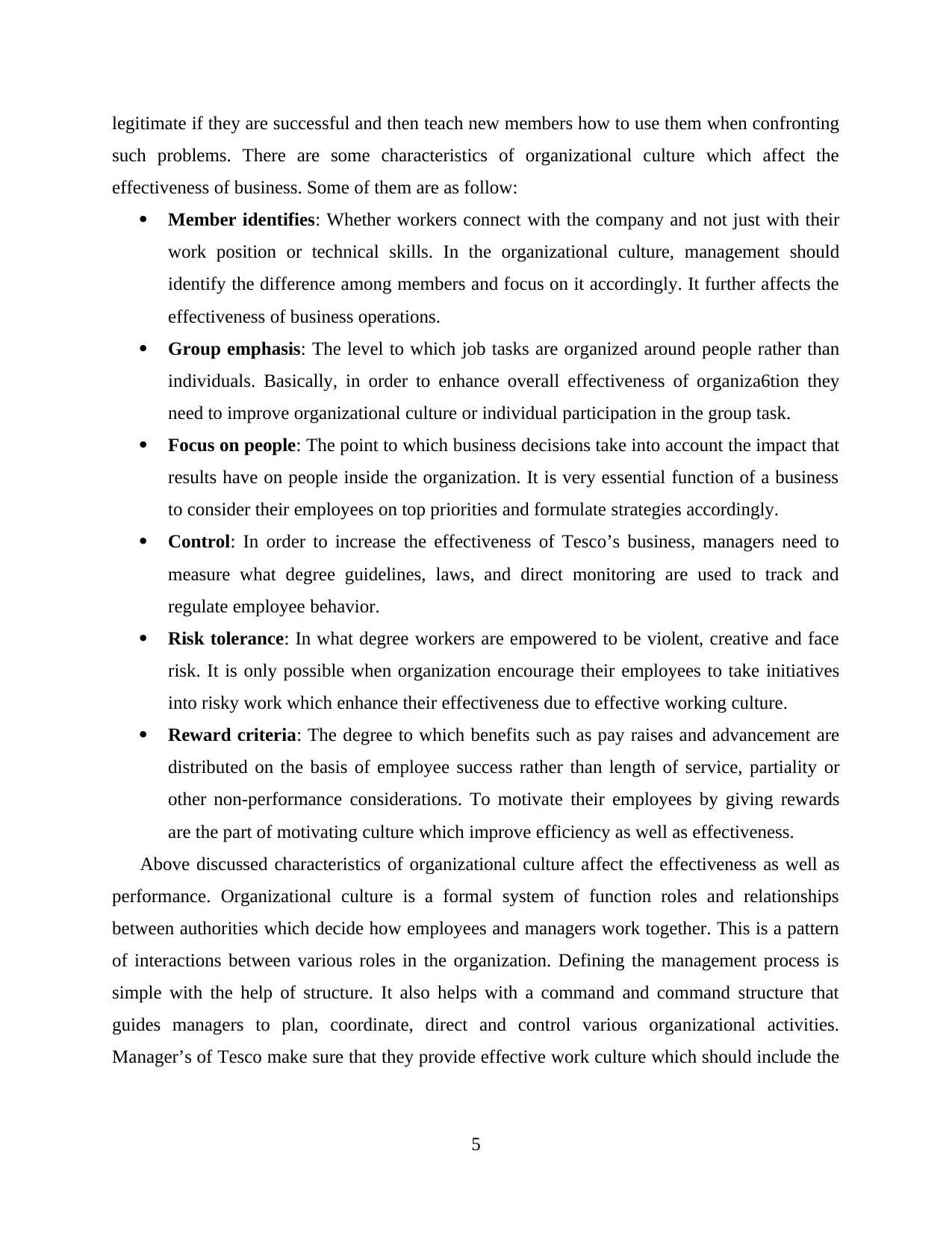
legitimate if they are successful and then teach new members how to use them when confronting
such problems. There are some characteristics of organizational culture which affect the
effectiveness of business. Some of them are as follow:
Member identifies: Whether workers connect with the company and not just with their
work position or technical skills. In the organizational culture, management should
identify the difference among members and focus on it accordingly. It further affects the
effectiveness of business operations.
Group emphasis: The level to which job tasks are organized around people rather than
individuals. Basically, in order to enhance overall effectiveness of organiza6tion they
need to improve organizational culture or individual participation in the group task.
Focus on people: The point to which business decisions take into account the impact that
results have on people inside the organization. It is very essential function of a business
to consider their employees on top priorities and formulate strategies accordingly.
Control: In order to increase the effectiveness of Tesco’s business, managers need to
measure what degree guidelines, laws, and direct monitoring are used to track and
regulate employee behavior.
Risk tolerance: In what degree workers are empowered to be violent, creative and face
risk. It is only possible when organization encourage their employees to take initiatives
into risky work which enhance their effectiveness due to effective working culture.
Reward criteria: The degree to which benefits such as pay raises and advancement are
distributed on the basis of employee success rather than length of service, partiality or
other non-performance considerations. To motivate their employees by giving rewards
are the part of motivating culture which improve efficiency as well as effectiveness.
Above discussed characteristics of organizational culture affect the effectiveness as well as
performance. Organizational culture is a formal system of function roles and relationships
between authorities which decide how employees and managers work together. This is a pattern
of interactions between various roles in the organization. Defining the management process is
simple with the help of structure. It also helps with a command and command structure that
guides managers to plan, coordinate, direct and control various organizational activities.
Manager’s of Tesco make sure that they provide effective work culture which should include the
5
such problems. There are some characteristics of organizational culture which affect the
effectiveness of business. Some of them are as follow:
Member identifies: Whether workers connect with the company and not just with their
work position or technical skills. In the organizational culture, management should
identify the difference among members and focus on it accordingly. It further affects the
effectiveness of business operations.
Group emphasis: The level to which job tasks are organized around people rather than
individuals. Basically, in order to enhance overall effectiveness of organiza6tion they
need to improve organizational culture or individual participation in the group task.
Focus on people: The point to which business decisions take into account the impact that
results have on people inside the organization. It is very essential function of a business
to consider their employees on top priorities and formulate strategies accordingly.
Control: In order to increase the effectiveness of Tesco’s business, managers need to
measure what degree guidelines, laws, and direct monitoring are used to track and
regulate employee behavior.
Risk tolerance: In what degree workers are empowered to be violent, creative and face
risk. It is only possible when organization encourage their employees to take initiatives
into risky work which enhance their effectiveness due to effective working culture.
Reward criteria: The degree to which benefits such as pay raises and advancement are
distributed on the basis of employee success rather than length of service, partiality or
other non-performance considerations. To motivate their employees by giving rewards
are the part of motivating culture which improve efficiency as well as effectiveness.
Above discussed characteristics of organizational culture affect the effectiveness as well as
performance. Organizational culture is a formal system of function roles and relationships
between authorities which decide how employees and managers work together. This is a pattern
of interactions between various roles in the organization. Defining the management process is
simple with the help of structure. It also helps with a command and command structure that
guides managers to plan, coordinate, direct and control various organizational activities.
Manager’s of Tesco make sure that they provide effective work culture which should include the
5
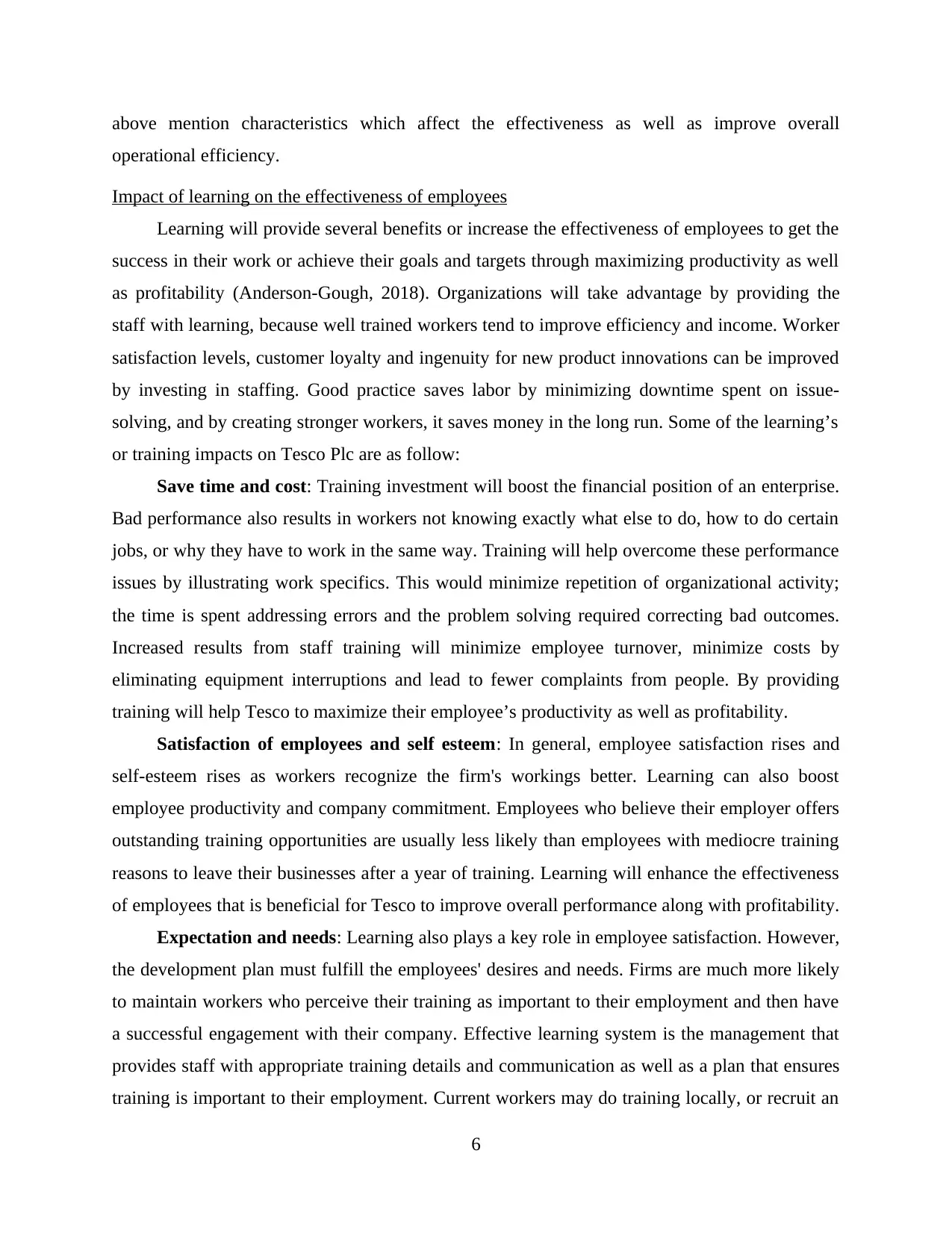
above mention characteristics which affect the effectiveness as well as improve overall
operational efficiency.
Impact of learning on the effectiveness of employees
Learning will provide several benefits or increase the effectiveness of employees to get the
success in their work or achieve their goals and targets through maximizing productivity as well
as profitability (Anderson-Gough, 2018). Organizations will take advantage by providing the
staff with learning, because well trained workers tend to improve efficiency and income. Worker
satisfaction levels, customer loyalty and ingenuity for new product innovations can be improved
by investing in staffing. Good practice saves labor by minimizing downtime spent on issue-
solving, and by creating stronger workers, it saves money in the long run. Some of the learning’s
or training impacts on Tesco Plc are as follow:
Save time and cost: Training investment will boost the financial position of an enterprise.
Bad performance also results in workers not knowing exactly what else to do, how to do certain
jobs, or why they have to work in the same way. Training will help overcome these performance
issues by illustrating work specifics. This would minimize repetition of organizational activity;
the time is spent addressing errors and the problem solving required correcting bad outcomes.
Increased results from staff training will minimize employee turnover, minimize costs by
eliminating equipment interruptions and lead to fewer complaints from people. By providing
training will help Tesco to maximize their employee’s productivity as well as profitability.
Satisfaction of employees and self esteem: In general, employee satisfaction rises and
self-esteem rises as workers recognize the firm's workings better. Learning can also boost
employee productivity and company commitment. Employees who believe their employer offers
outstanding training opportunities are usually less likely than employees with mediocre training
reasons to leave their businesses after a year of training. Learning will enhance the effectiveness
of employees that is beneficial for Tesco to improve overall performance along with profitability.
Expectation and needs: Learning also plays a key role in employee satisfaction. However,
the development plan must fulfill the employees' desires and needs. Firms are much more likely
to maintain workers who perceive their training as important to their employment and then have
a successful engagement with their company. Effective learning system is the management that
provides staff with appropriate training details and communication as well as a plan that ensures
training is important to their employment. Current workers may do training locally, or recruit an
6
operational efficiency.
Impact of learning on the effectiveness of employees
Learning will provide several benefits or increase the effectiveness of employees to get the
success in their work or achieve their goals and targets through maximizing productivity as well
as profitability (Anderson-Gough, 2018). Organizations will take advantage by providing the
staff with learning, because well trained workers tend to improve efficiency and income. Worker
satisfaction levels, customer loyalty and ingenuity for new product innovations can be improved
by investing in staffing. Good practice saves labor by minimizing downtime spent on issue-
solving, and by creating stronger workers, it saves money in the long run. Some of the learning’s
or training impacts on Tesco Plc are as follow:
Save time and cost: Training investment will boost the financial position of an enterprise.
Bad performance also results in workers not knowing exactly what else to do, how to do certain
jobs, or why they have to work in the same way. Training will help overcome these performance
issues by illustrating work specifics. This would minimize repetition of organizational activity;
the time is spent addressing errors and the problem solving required correcting bad outcomes.
Increased results from staff training will minimize employee turnover, minimize costs by
eliminating equipment interruptions and lead to fewer complaints from people. By providing
training will help Tesco to maximize their employee’s productivity as well as profitability.
Satisfaction of employees and self esteem: In general, employee satisfaction rises and
self-esteem rises as workers recognize the firm's workings better. Learning can also boost
employee productivity and company commitment. Employees who believe their employer offers
outstanding training opportunities are usually less likely than employees with mediocre training
reasons to leave their businesses after a year of training. Learning will enhance the effectiveness
of employees that is beneficial for Tesco to improve overall performance along with profitability.
Expectation and needs: Learning also plays a key role in employee satisfaction. However,
the development plan must fulfill the employees' desires and needs. Firms are much more likely
to maintain workers who perceive their training as important to their employment and then have
a successful engagement with their company. Effective learning system is the management that
provides staff with appropriate training details and communication as well as a plan that ensures
training is important to their employment. Current workers may do training locally, or recruit an
6
⊘ This is a preview!⊘
Do you want full access?
Subscribe today to unlock all pages.

Trusted by 1+ million students worldwide
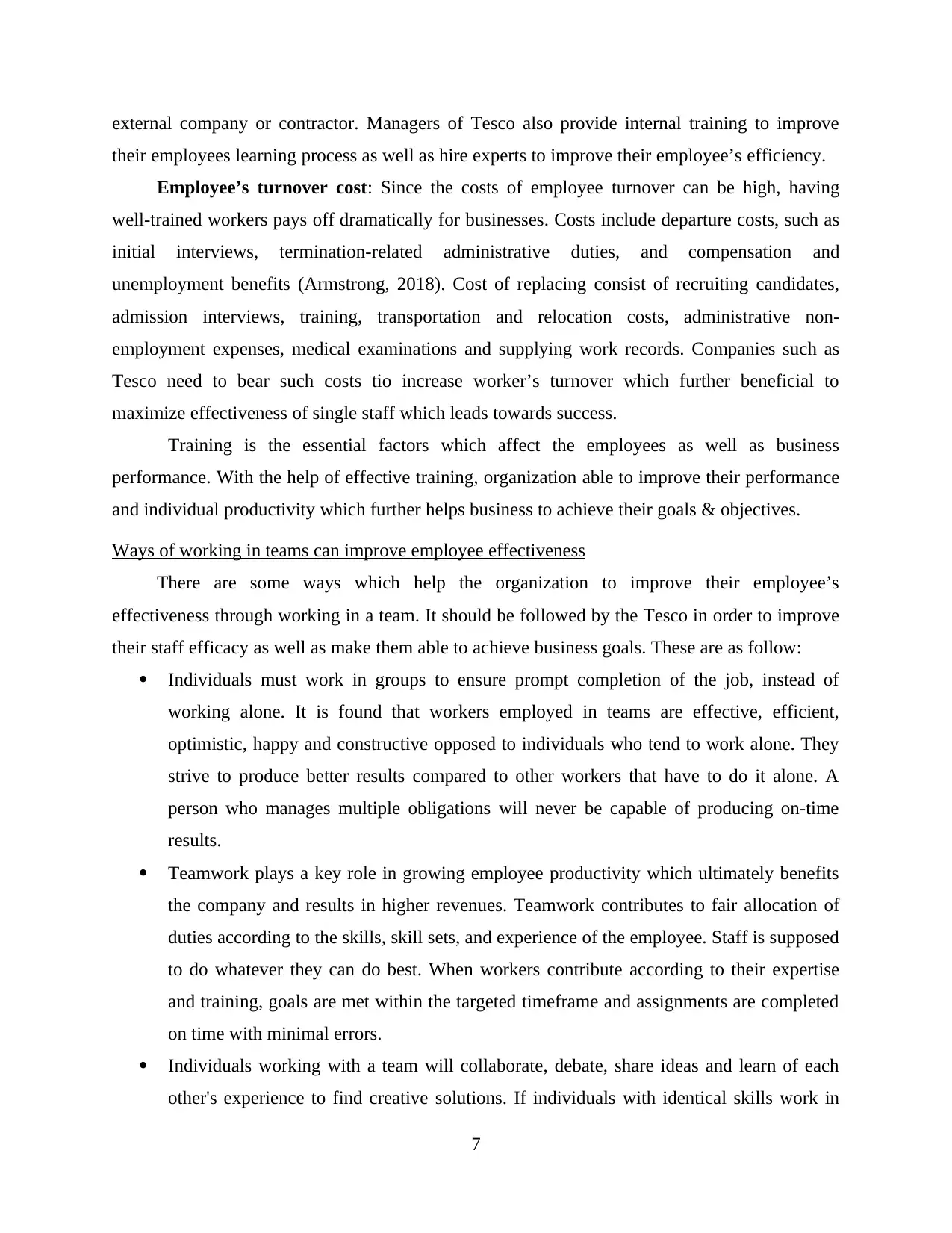
external company or contractor. Managers of Tesco also provide internal training to improve
their employees learning process as well as hire experts to improve their employee’s efficiency.
Employee’s turnover cost: Since the costs of employee turnover can be high, having
well-trained workers pays off dramatically for businesses. Costs include departure costs, such as
initial interviews, termination-related administrative duties, and compensation and
unemployment benefits (Armstrong, 2018). Cost of replacing consist of recruiting candidates,
admission interviews, training, transportation and relocation costs, administrative non-
employment expenses, medical examinations and supplying work records. Companies such as
Tesco need to bear such costs tio increase worker’s turnover which further beneficial to
maximize effectiveness of single staff which leads towards success.
Training is the essential factors which affect the employees as well as business
performance. With the help of effective training, organization able to improve their performance
and individual productivity which further helps business to achieve their goals & objectives.
Ways of working in teams can improve employee effectiveness
There are some ways which help the organization to improve their employee’s
effectiveness through working in a team. It should be followed by the Tesco in order to improve
their staff efficacy as well as make them able to achieve business goals. These are as follow:
Individuals must work in groups to ensure prompt completion of the job, instead of
working alone. It is found that workers employed in teams are effective, efficient,
optimistic, happy and constructive opposed to individuals who tend to work alone. They
strive to produce better results compared to other workers that have to do it alone. A
person who manages multiple obligations will never be capable of producing on-time
results.
Teamwork plays a key role in growing employee productivity which ultimately benefits
the company and results in higher revenues. Teamwork contributes to fair allocation of
duties according to the skills, skill sets, and experience of the employee. Staff is supposed
to do whatever they can do best. When workers contribute according to their expertise
and training, goals are met within the targeted timeframe and assignments are completed
on time with minimal errors.
Individuals working with a team will collaborate, debate, share ideas and learn of each
other's experience to find creative solutions. If individuals with identical skills work in
7
their employees learning process as well as hire experts to improve their employee’s efficiency.
Employee’s turnover cost: Since the costs of employee turnover can be high, having
well-trained workers pays off dramatically for businesses. Costs include departure costs, such as
initial interviews, termination-related administrative duties, and compensation and
unemployment benefits (Armstrong, 2018). Cost of replacing consist of recruiting candidates,
admission interviews, training, transportation and relocation costs, administrative non-
employment expenses, medical examinations and supplying work records. Companies such as
Tesco need to bear such costs tio increase worker’s turnover which further beneficial to
maximize effectiveness of single staff which leads towards success.
Training is the essential factors which affect the employees as well as business
performance. With the help of effective training, organization able to improve their performance
and individual productivity which further helps business to achieve their goals & objectives.
Ways of working in teams can improve employee effectiveness
There are some ways which help the organization to improve their employee’s
effectiveness through working in a team. It should be followed by the Tesco in order to improve
their staff efficacy as well as make them able to achieve business goals. These are as follow:
Individuals must work in groups to ensure prompt completion of the job, instead of
working alone. It is found that workers employed in teams are effective, efficient,
optimistic, happy and constructive opposed to individuals who tend to work alone. They
strive to produce better results compared to other workers that have to do it alone. A
person who manages multiple obligations will never be capable of producing on-time
results.
Teamwork plays a key role in growing employee productivity which ultimately benefits
the company and results in higher revenues. Teamwork contributes to fair allocation of
duties according to the skills, skill sets, and experience of the employee. Staff is supposed
to do whatever they can do best. When workers contribute according to their expertise
and training, goals are met within the targeted timeframe and assignments are completed
on time with minimal errors.
Individuals working with a team will collaborate, debate, share ideas and learn of each
other's experience to find creative solutions. If individuals with identical skills work in
7
Paraphrase This Document
Need a fresh take? Get an instant paraphrase of this document with our AI Paraphraser
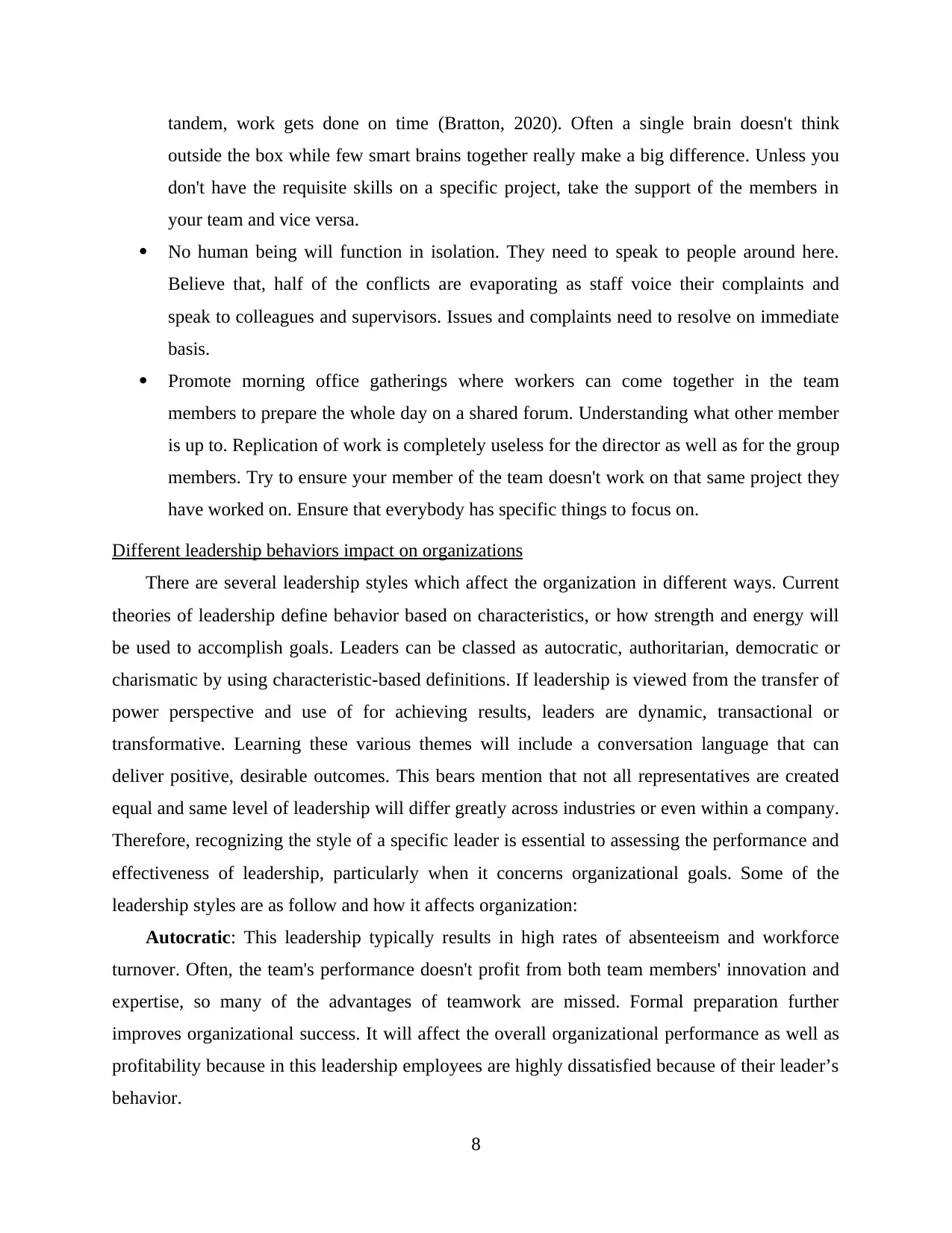
tandem, work gets done on time (Bratton, 2020). Often a single brain doesn't think
outside the box while few smart brains together really make a big difference. Unless you
don't have the requisite skills on a specific project, take the support of the members in
your team and vice versa.
No human being will function in isolation. They need to speak to people around here.
Believe that, half of the conflicts are evaporating as staff voice their complaints and
speak to colleagues and supervisors. Issues and complaints need to resolve on immediate
basis.
Promote morning office gatherings where workers can come together in the team
members to prepare the whole day on a shared forum. Understanding what other member
is up to. Replication of work is completely useless for the director as well as for the group
members. Try to ensure your member of the team doesn't work on that same project they
have worked on. Ensure that everybody has specific things to focus on.
Different leadership behaviors impact on organizations
There are several leadership styles which affect the organization in different ways. Current
theories of leadership define behavior based on characteristics, or how strength and energy will
be used to accomplish goals. Leaders can be classed as autocratic, authoritarian, democratic or
charismatic by using characteristic-based definitions. If leadership is viewed from the transfer of
power perspective and use of for achieving results, leaders are dynamic, transactional or
transformative. Learning these various themes will include a conversation language that can
deliver positive, desirable outcomes. This bears mention that not all representatives are created
equal and same level of leadership will differ greatly across industries or even within a company.
Therefore, recognizing the style of a specific leader is essential to assessing the performance and
effectiveness of leadership, particularly when it concerns organizational goals. Some of the
leadership styles are as follow and how it affects organization:
Autocratic: This leadership typically results in high rates of absenteeism and workforce
turnover. Often, the team's performance doesn't profit from both team members' innovation and
expertise, so many of the advantages of teamwork are missed. Formal preparation further
improves organizational success. It will affect the overall organizational performance as well as
profitability because in this leadership employees are highly dissatisfied because of their leader’s
behavior.
8
outside the box while few smart brains together really make a big difference. Unless you
don't have the requisite skills on a specific project, take the support of the members in
your team and vice versa.
No human being will function in isolation. They need to speak to people around here.
Believe that, half of the conflicts are evaporating as staff voice their complaints and
speak to colleagues and supervisors. Issues and complaints need to resolve on immediate
basis.
Promote morning office gatherings where workers can come together in the team
members to prepare the whole day on a shared forum. Understanding what other member
is up to. Replication of work is completely useless for the director as well as for the group
members. Try to ensure your member of the team doesn't work on that same project they
have worked on. Ensure that everybody has specific things to focus on.
Different leadership behaviors impact on organizations
There are several leadership styles which affect the organization in different ways. Current
theories of leadership define behavior based on characteristics, or how strength and energy will
be used to accomplish goals. Leaders can be classed as autocratic, authoritarian, democratic or
charismatic by using characteristic-based definitions. If leadership is viewed from the transfer of
power perspective and use of for achieving results, leaders are dynamic, transactional or
transformative. Learning these various themes will include a conversation language that can
deliver positive, desirable outcomes. This bears mention that not all representatives are created
equal and same level of leadership will differ greatly across industries or even within a company.
Therefore, recognizing the style of a specific leader is essential to assessing the performance and
effectiveness of leadership, particularly when it concerns organizational goals. Some of the
leadership styles are as follow and how it affects organization:
Autocratic: This leadership typically results in high rates of absenteeism and workforce
turnover. Often, the team's performance doesn't profit from both team members' innovation and
expertise, so many of the advantages of teamwork are missed. Formal preparation further
improves organizational success. It will affect the overall organizational performance as well as
profitability because in this leadership employees are highly dissatisfied because of their leader’s
behavior.
8
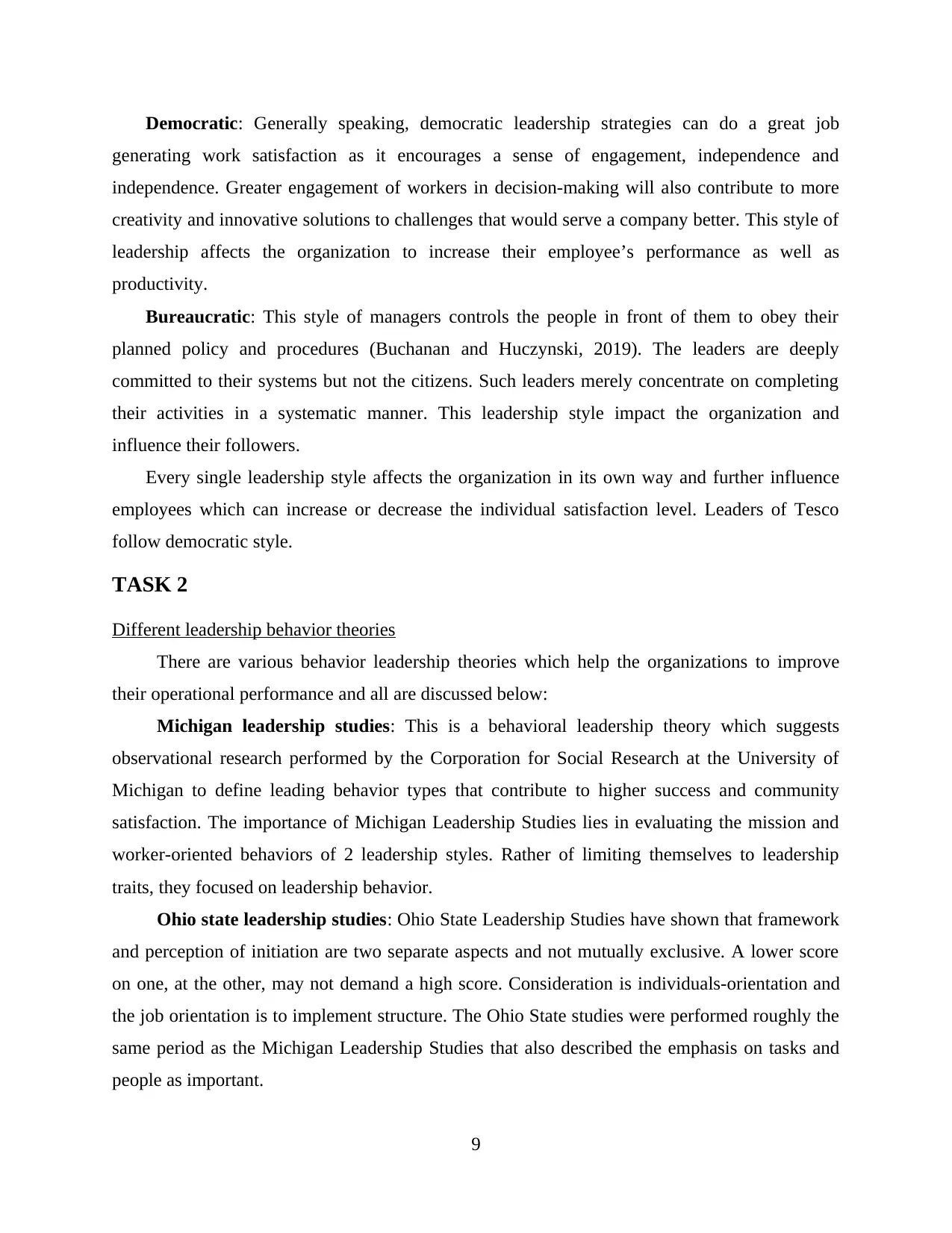
Democratic: Generally speaking, democratic leadership strategies can do a great job
generating work satisfaction as it encourages a sense of engagement, independence and
independence. Greater engagement of workers in decision-making will also contribute to more
creativity and innovative solutions to challenges that would serve a company better. This style of
leadership affects the organization to increase their employee’s performance as well as
productivity.
Bureaucratic: This style of managers controls the people in front of them to obey their
planned policy and procedures (Buchanan and Huczynski, 2019). The leaders are deeply
committed to their systems but not the citizens. Such leaders merely concentrate on completing
their activities in a systematic manner. This leadership style impact the organization and
influence their followers.
Every single leadership style affects the organization in its own way and further influence
employees which can increase or decrease the individual satisfaction level. Leaders of Tesco
follow democratic style.
TASK 2
Different leadership behavior theories
There are various behavior leadership theories which help the organizations to improve
their operational performance and all are discussed below:
Michigan leadership studies: This is a behavioral leadership theory which suggests
observational research performed by the Corporation for Social Research at the University of
Michigan to define leading behavior types that contribute to higher success and community
satisfaction. The importance of Michigan Leadership Studies lies in evaluating the mission and
worker-oriented behaviors of 2 leadership styles. Rather of limiting themselves to leadership
traits, they focused on leadership behavior.
Ohio state leadership studies: Ohio State Leadership Studies have shown that framework
and perception of initiation are two separate aspects and not mutually exclusive. A lower score
on one, at the other, may not demand a high score. Consideration is individuals-orientation and
the job orientation is to implement structure. The Ohio State studies were performed roughly the
same period as the Michigan Leadership Studies that also described the emphasis on tasks and
people as important.
9
generating work satisfaction as it encourages a sense of engagement, independence and
independence. Greater engagement of workers in decision-making will also contribute to more
creativity and innovative solutions to challenges that would serve a company better. This style of
leadership affects the organization to increase their employee’s performance as well as
productivity.
Bureaucratic: This style of managers controls the people in front of them to obey their
planned policy and procedures (Buchanan and Huczynski, 2019). The leaders are deeply
committed to their systems but not the citizens. Such leaders merely concentrate on completing
their activities in a systematic manner. This leadership style impact the organization and
influence their followers.
Every single leadership style affects the organization in its own way and further influence
employees which can increase or decrease the individual satisfaction level. Leaders of Tesco
follow democratic style.
TASK 2
Different leadership behavior theories
There are various behavior leadership theories which help the organizations to improve
their operational performance and all are discussed below:
Michigan leadership studies: This is a behavioral leadership theory which suggests
observational research performed by the Corporation for Social Research at the University of
Michigan to define leading behavior types that contribute to higher success and community
satisfaction. The importance of Michigan Leadership Studies lies in evaluating the mission and
worker-oriented behaviors of 2 leadership styles. Rather of limiting themselves to leadership
traits, they focused on leadership behavior.
Ohio state leadership studies: Ohio State Leadership Studies have shown that framework
and perception of initiation are two separate aspects and not mutually exclusive. A lower score
on one, at the other, may not demand a high score. Consideration is individuals-orientation and
the job orientation is to implement structure. The Ohio State studies were performed roughly the
same period as the Michigan Leadership Studies that also described the emphasis on tasks and
people as important.
9
⊘ This is a preview!⊘
Do you want full access?
Subscribe today to unlock all pages.

Trusted by 1+ million students worldwide
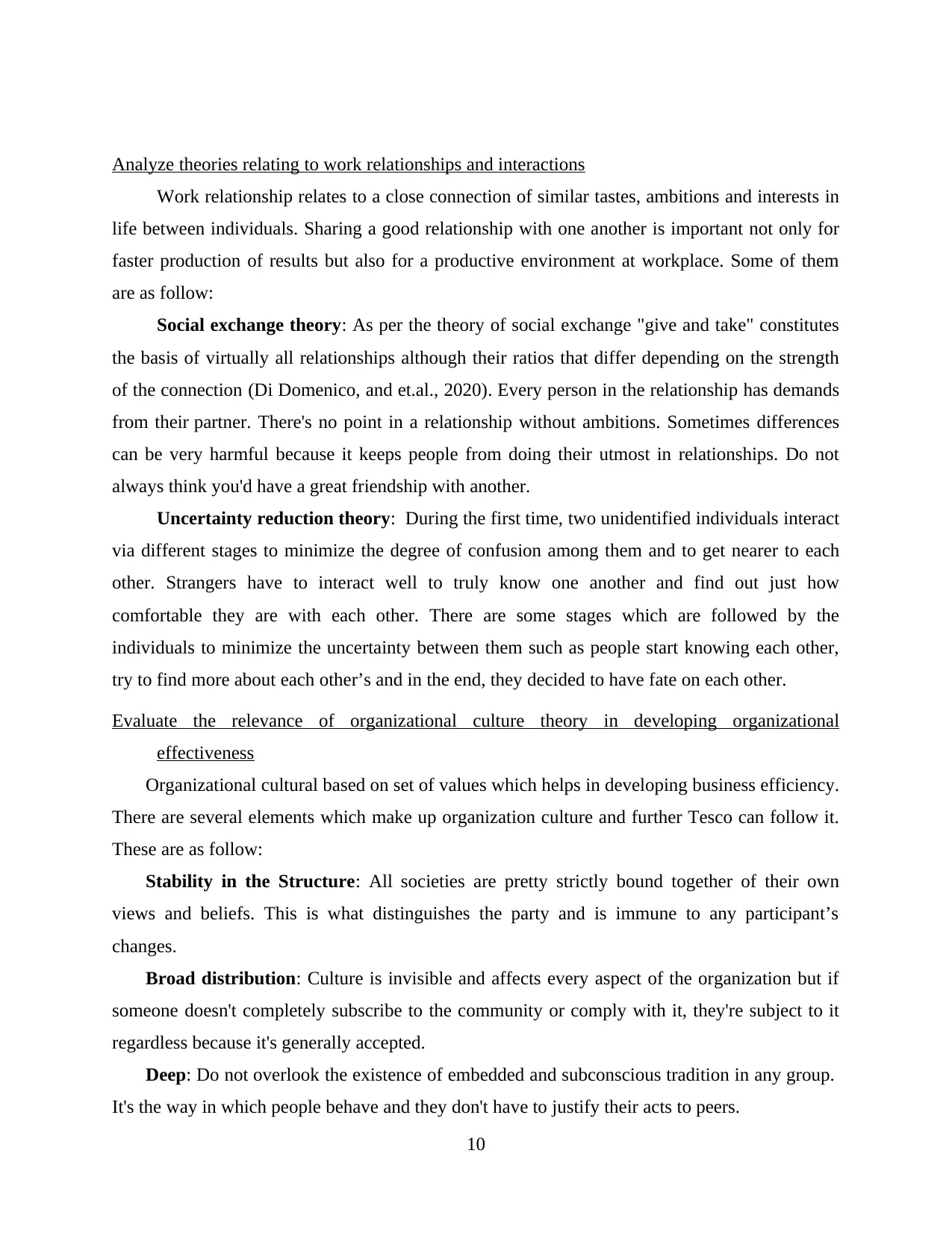
Analyze theories relating to work relationships and interactions
Work relationship relates to a close connection of similar tastes, ambitions and interests in
life between individuals. Sharing a good relationship with one another is important not only for
faster production of results but also for a productive environment at workplace. Some of them
are as follow:
Social exchange theory: As per the theory of social exchange "give and take" constitutes
the basis of virtually all relationships although their ratios that differ depending on the strength
of the connection (Di Domenico, and et.al., 2020). Every person in the relationship has demands
from their partner. There's no point in a relationship without ambitions. Sometimes differences
can be very harmful because it keeps people from doing their utmost in relationships. Do not
always think you'd have a great friendship with another.
Uncertainty reduction theory: During the first time, two unidentified individuals interact
via different stages to minimize the degree of confusion among them and to get nearer to each
other. Strangers have to interact well to truly know one another and find out just how
comfortable they are with each other. There are some stages which are followed by the
individuals to minimize the uncertainty between them such as people start knowing each other,
try to find more about each other’s and in the end, they decided to have fate on each other.
Evaluate the relevance of organizational culture theory in developing organizational
effectiveness
Organizational cultural based on set of values which helps in developing business efficiency.
There are several elements which make up organization culture and further Tesco can follow it.
These are as follow:
Stability in the Structure: All societies are pretty strictly bound together of their own
views and beliefs. This is what distinguishes the party and is immune to any participant’s
changes.
Broad distribution: Culture is invisible and affects every aspect of the organization but if
someone doesn't completely subscribe to the community or comply with it, they're subject to it
regardless because it's generally accepted.
Deep: Do not overlook the existence of embedded and subconscious tradition in any group.
It's the way in which people behave and they don't have to justify their acts to peers.
10
Work relationship relates to a close connection of similar tastes, ambitions and interests in
life between individuals. Sharing a good relationship with one another is important not only for
faster production of results but also for a productive environment at workplace. Some of them
are as follow:
Social exchange theory: As per the theory of social exchange "give and take" constitutes
the basis of virtually all relationships although their ratios that differ depending on the strength
of the connection (Di Domenico, and et.al., 2020). Every person in the relationship has demands
from their partner. There's no point in a relationship without ambitions. Sometimes differences
can be very harmful because it keeps people from doing their utmost in relationships. Do not
always think you'd have a great friendship with another.
Uncertainty reduction theory: During the first time, two unidentified individuals interact
via different stages to minimize the degree of confusion among them and to get nearer to each
other. Strangers have to interact well to truly know one another and find out just how
comfortable they are with each other. There are some stages which are followed by the
individuals to minimize the uncertainty between them such as people start knowing each other,
try to find more about each other’s and in the end, they decided to have fate on each other.
Evaluate the relevance of organizational culture theory in developing organizational
effectiveness
Organizational cultural based on set of values which helps in developing business efficiency.
There are several elements which make up organization culture and further Tesco can follow it.
These are as follow:
Stability in the Structure: All societies are pretty strictly bound together of their own
views and beliefs. This is what distinguishes the party and is immune to any participant’s
changes.
Broad distribution: Culture is invisible and affects every aspect of the organization but if
someone doesn't completely subscribe to the community or comply with it, they're subject to it
regardless because it's generally accepted.
Deep: Do not overlook the existence of embedded and subconscious tradition in any group.
It's the way in which people behave and they don't have to justify their acts to peers.
10
Paraphrase This Document
Need a fresh take? Get an instant paraphrase of this document with our AI Paraphraser
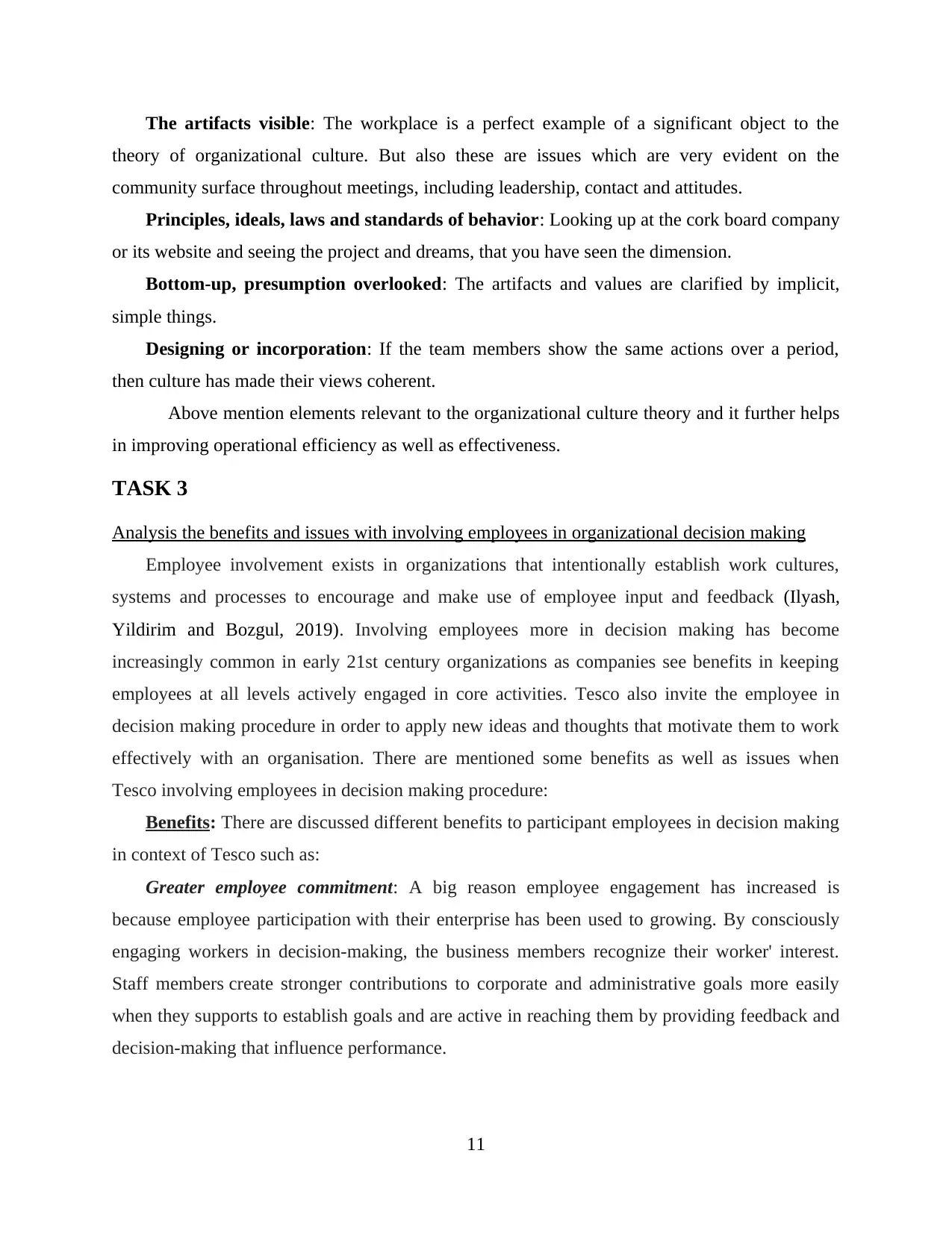
The artifacts visible: The workplace is a perfect example of a significant object to the
theory of organizational culture. But also these are issues which are very evident on the
community surface throughout meetings, including leadership, contact and attitudes.
Principles, ideals, laws and standards of behavior: Looking up at the cork board company
or its website and seeing the project and dreams, that you have seen the dimension.
Bottom-up, presumption overlooked: The artifacts and values are clarified by implicit,
simple things.
Designing or incorporation: If the team members show the same actions over a period,
then culture has made their views coherent.
Above mention elements relevant to the organizational culture theory and it further helps
in improving operational efficiency as well as effectiveness.
TASK 3
Analysis the benefits and issues with involving employees in organizational decision making
Employee involvement exists in organizations that intentionally establish work cultures,
systems and processes to encourage and make use of employee input and feedback (Ilyash,
Yildirim and Bozgul, 2019). Involving employees more in decision making has become
increasingly common in early 21st century organizations as companies see benefits in keeping
employees at all levels actively engaged in core activities. Tesco also invite the employee in
decision making procedure in order to apply new ideas and thoughts that motivate them to work
effectively with an organisation. There are mentioned some benefits as well as issues when
Tesco involving employees in decision making procedure:
Benefits: There are discussed different benefits to participant employees in decision making
in context of Tesco such as:
Greater employee commitment: A big reason employee engagement has increased is
because employee participation with their enterprise has been used to growing. By consciously
engaging workers in decision-making, the business members recognize their worker' interest.
Staff members create stronger contributions to corporate and administrative goals more easily
when they supports to establish goals and are active in reaching them by providing feedback and
decision-making that influence performance.
11
theory of organizational culture. But also these are issues which are very evident on the
community surface throughout meetings, including leadership, contact and attitudes.
Principles, ideals, laws and standards of behavior: Looking up at the cork board company
or its website and seeing the project and dreams, that you have seen the dimension.
Bottom-up, presumption overlooked: The artifacts and values are clarified by implicit,
simple things.
Designing or incorporation: If the team members show the same actions over a period,
then culture has made their views coherent.
Above mention elements relevant to the organizational culture theory and it further helps
in improving operational efficiency as well as effectiveness.
TASK 3
Analysis the benefits and issues with involving employees in organizational decision making
Employee involvement exists in organizations that intentionally establish work cultures,
systems and processes to encourage and make use of employee input and feedback (Ilyash,
Yildirim and Bozgul, 2019). Involving employees more in decision making has become
increasingly common in early 21st century organizations as companies see benefits in keeping
employees at all levels actively engaged in core activities. Tesco also invite the employee in
decision making procedure in order to apply new ideas and thoughts that motivate them to work
effectively with an organisation. There are mentioned some benefits as well as issues when
Tesco involving employees in decision making procedure:
Benefits: There are discussed different benefits to participant employees in decision making
in context of Tesco such as:
Greater employee commitment: A big reason employee engagement has increased is
because employee participation with their enterprise has been used to growing. By consciously
engaging workers in decision-making, the business members recognize their worker' interest.
Staff members create stronger contributions to corporate and administrative goals more easily
when they supports to establish goals and are active in reaching them by providing feedback and
decision-making that influence performance.
11
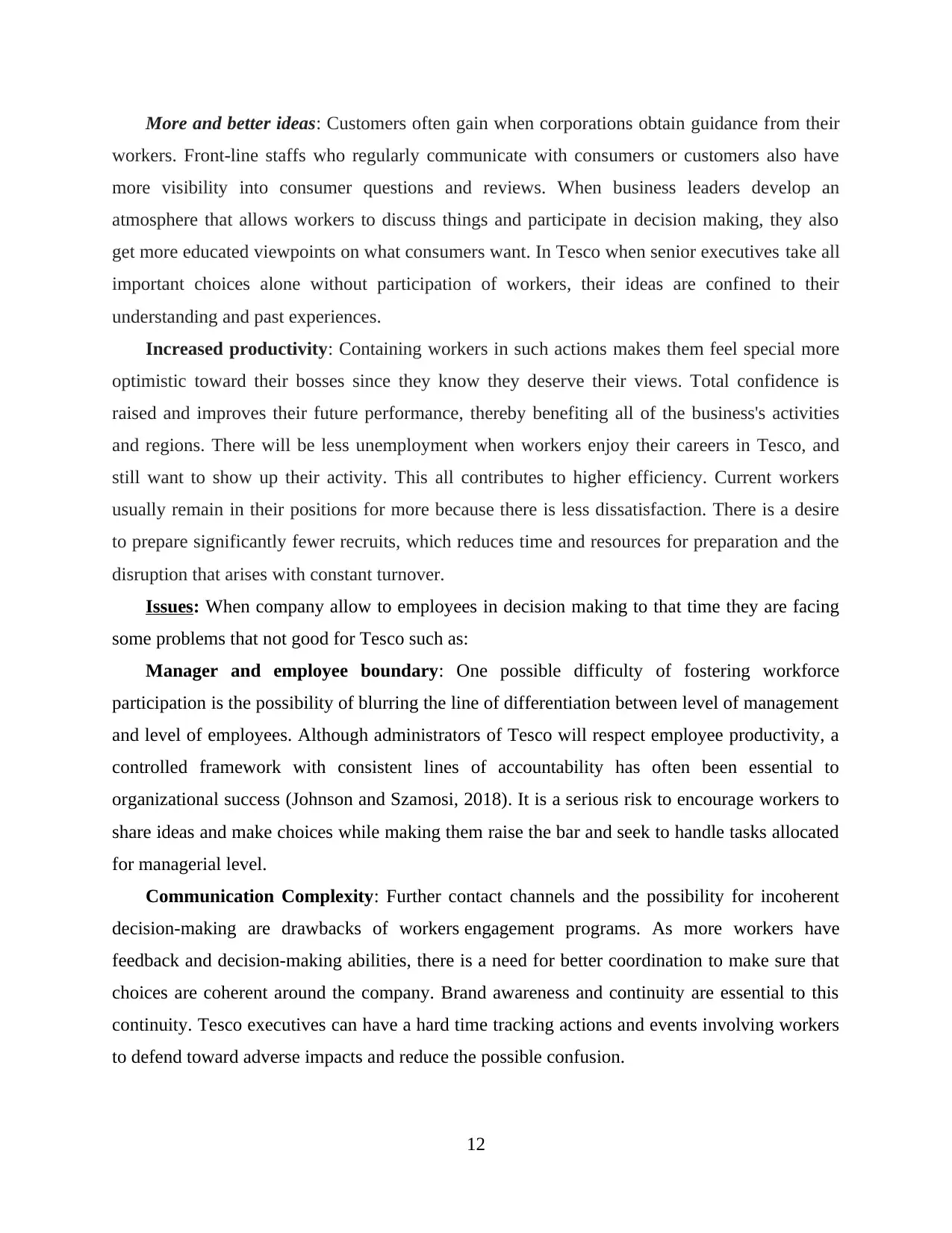
More and better ideas: Customers often gain when corporations obtain guidance from their
workers. Front-line staffs who regularly communicate with consumers or customers also have
more visibility into consumer questions and reviews. When business leaders develop an
atmosphere that allows workers to discuss things and participate in decision making, they also
get more educated viewpoints on what consumers want. In Tesco when senior executives take all
important choices alone without participation of workers, their ideas are confined to their
understanding and past experiences.
Increased productivity: Containing workers in such actions makes them feel special more
optimistic toward their bosses since they know they deserve their views. Total confidence is
raised and improves their future performance, thereby benefiting all of the business's activities
and regions. There will be less unemployment when workers enjoy their careers in Tesco, and
still want to show up their activity. This all contributes to higher efficiency. Current workers
usually remain in their positions for more because there is less dissatisfaction. There is a desire
to prepare significantly fewer recruits, which reduces time and resources for preparation and the
disruption that arises with constant turnover.
Issues: When company allow to employees in decision making to that time they are facing
some problems that not good for Tesco such as:
Manager and employee boundary: One possible difficulty of fostering workforce
participation is the possibility of blurring the line of differentiation between level of management
and level of employees. Although administrators of Tesco will respect employee productivity, a
controlled framework with consistent lines of accountability has often been essential to
organizational success (Johnson and Szamosi, 2018). It is a serious risk to encourage workers to
share ideas and make choices while making them raise the bar and seek to handle tasks allocated
for managerial level.
Communication Complexity: Further contact channels and the possibility for incoherent
decision-making are drawbacks of workers engagement programs. As more workers have
feedback and decision-making abilities, there is a need for better coordination to make sure that
choices are coherent around the company. Brand awareness and continuity are essential to this
continuity. Tesco executives can have a hard time tracking actions and events involving workers
to defend toward adverse impacts and reduce the possible confusion.
12
workers. Front-line staffs who regularly communicate with consumers or customers also have
more visibility into consumer questions and reviews. When business leaders develop an
atmosphere that allows workers to discuss things and participate in decision making, they also
get more educated viewpoints on what consumers want. In Tesco when senior executives take all
important choices alone without participation of workers, their ideas are confined to their
understanding and past experiences.
Increased productivity: Containing workers in such actions makes them feel special more
optimistic toward their bosses since they know they deserve their views. Total confidence is
raised and improves their future performance, thereby benefiting all of the business's activities
and regions. There will be less unemployment when workers enjoy their careers in Tesco, and
still want to show up their activity. This all contributes to higher efficiency. Current workers
usually remain in their positions for more because there is less dissatisfaction. There is a desire
to prepare significantly fewer recruits, which reduces time and resources for preparation and the
disruption that arises with constant turnover.
Issues: When company allow to employees in decision making to that time they are facing
some problems that not good for Tesco such as:
Manager and employee boundary: One possible difficulty of fostering workforce
participation is the possibility of blurring the line of differentiation between level of management
and level of employees. Although administrators of Tesco will respect employee productivity, a
controlled framework with consistent lines of accountability has often been essential to
organizational success (Johnson and Szamosi, 2018). It is a serious risk to encourage workers to
share ideas and make choices while making them raise the bar and seek to handle tasks allocated
for managerial level.
Communication Complexity: Further contact channels and the possibility for incoherent
decision-making are drawbacks of workers engagement programs. As more workers have
feedback and decision-making abilities, there is a need for better coordination to make sure that
choices are coherent around the company. Brand awareness and continuity are essential to this
continuity. Tesco executives can have a hard time tracking actions and events involving workers
to defend toward adverse impacts and reduce the possible confusion.
12
⊘ This is a preview!⊘
Do you want full access?
Subscribe today to unlock all pages.

Trusted by 1+ million students worldwide
1 out of 15
Related Documents
Your All-in-One AI-Powered Toolkit for Academic Success.
+13062052269
info@desklib.com
Available 24*7 on WhatsApp / Email
![[object Object]](/_next/static/media/star-bottom.7253800d.svg)
Unlock your academic potential
Copyright © 2020–2025 A2Z Services. All Rights Reserved. Developed and managed by ZUCOL.




